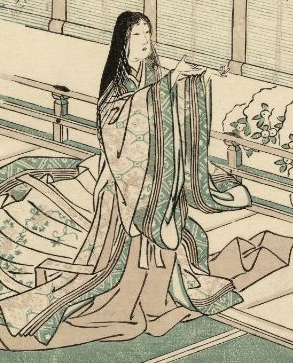Benizuri-e (紅刷絵, "crimson printed pictures") are a type of "primitive" ukiyo-e style Japanese woodblock prints. They were usually printed in pink (beni) and green, occasionally with the addition of another color, either printed or added by hand.
The production of benizuri-e reached its peak in the early 1740s. Torii Kiyohiro, Torii Kiyomitsu I, Torii Kiyonobu I, Okumura Masanobu, Nishimura Shigenaga, and Ishikawa Toyonobu are the artists most closely associated with benizuri-e.
Gallery of benizuri-e
-
 Woodblock print by Ishikawa Toyonobu of kabuki actors Onoe Kikugorō I and Nakamura Kiyosaburō as a young seated couple playing a shamisen signed 'Meijōdō Ishikawa Shūha Toyonobu zu', 1750-1758
Woodblock print by Ishikawa Toyonobu of kabuki actors Onoe Kikugorō I and Nakamura Kiyosaburō as a young seated couple playing a shamisen signed 'Meijōdō Ishikawa Shūha Toyonobu zu', 1750-1758
-
 Woodblock print by Ishikawa Toyonobu of kabuki actors Nakamura Shichisaburō II and Sanogawa Ichimatsu, signed 'Meijōdō Ishikawa Shūha Toyonobu zu', 1740s
Woodblock print by Ishikawa Toyonobu of kabuki actors Nakamura Shichisaburō II and Sanogawa Ichimatsu, signed 'Meijōdō Ishikawa Shūha Toyonobu zu', 1740s
-
 Actor Ichikawa Ebizō II as Yanone Gorō in the kabuki play Koizome Sumidagawa, woodblock print by Torii Kiyomitsu I, Honolulu Museum of Art
Actor Ichikawa Ebizō II as Yanone Gorō in the kabuki play Koizome Sumidagawa, woodblock print by Torii Kiyomitsu I, Honolulu Museum of Art
-
 18th century Benizuri-e of Sei Shōnagon, author of The Pillow Book, attributed to Tsukioka Settei
18th century Benizuri-e of Sei Shōnagon, author of The Pillow Book, attributed to Tsukioka Settei
References
- Lane, Richard. (1978). Images from the Floating World, The Japanese Print. Oxford: Oxford University Press. ISBN 9780192114471; OCLC 5246796
- Newland, Amy Reigle. (2005). Hotei Encyclopedia of Japanese Woodblock Prints. Amsterdam: Hotei. ISBN 9789074822657; OCLC 61666175
- Roberts, Laurance P., A Dictionary of Japanese Artists, Tokyo, Weatherhill, 1976, 218.
| Ukiyo-e | ||
|---|---|---|
| General |  | |
| Themes |
| |
| Region specific themes | ||
| Techniques | ||
| Schools | ||
| Related traditions | ||